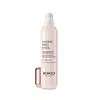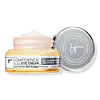What's inside
What's inside
 Key Ingredients
Key Ingredients

 Benefits
Benefits

 Concerns
Concerns

 Ingredients Side-by-side
Ingredients Side-by-side

Water
Skin ConditioningButylene Glycol
HumectantGlyceryl Stearate
EmollientHelianthus Annuus Seed Oil
EmollientPEG-100 Stearate
Glycerin
HumectantBehenyl Alcohol
EmollientEthylhexyl Palmitate
EmollientSimmondsia Chinensis Seed Oil
EmollientNiacinamide
SmoothingAcacia Senegal Gum
MaskingCaprylyl Glycol
EmollientPhenoxyethanol
PreservativeCaffeine
Skin ConditioningCarnitine Hcl
HumectantMica
Cosmetic ColorantCetearyl Alcohol
EmollientCarbomer
Emulsion StabilisingEthylhexylglycerin
Skin ConditioningAllantoin
Skin ConditioningHexylene Glycol
EmulsifyingSodium Hydroxide
BufferingHydrolyzed Rhizobian Gum
Potassium Behenoyl Hydroxyproline
AntioxidantDisodium EDTA
Pentadecalactone
MaskingSodium Hyaluronate
HumectantTocopherol
AntioxidantBehenic Acid
CleansingGlycine Soja Oil
EmollientPortulaca Oleracea Extract
Skin ConditioningTin Oxide
AbrasiveCapsicum Annuum Leaf Extract
Skin ConditioningRosa Centifolia Flower Extract
AstringentNicotiana Sylvestris Leaf Cell Culture
Skin ConditioningCI 77891
Cosmetic ColorantWater, Butylene Glycol, Glyceryl Stearate, Helianthus Annuus Seed Oil, PEG-100 Stearate, Glycerin, Behenyl Alcohol, Ethylhexyl Palmitate, Simmondsia Chinensis Seed Oil, Niacinamide, Acacia Senegal Gum, Caprylyl Glycol, Phenoxyethanol, Caffeine, Carnitine Hcl, Mica, Cetearyl Alcohol, Carbomer, Ethylhexylglycerin, Allantoin, Hexylene Glycol, Sodium Hydroxide, Hydrolyzed Rhizobian Gum, Potassium Behenoyl Hydroxyproline, Disodium EDTA, Pentadecalactone, Sodium Hyaluronate, Tocopherol, Behenic Acid, Glycine Soja Oil, Portulaca Oleracea Extract, Tin Oxide, Capsicum Annuum Leaf Extract, Rosa Centifolia Flower Extract, Nicotiana Sylvestris Leaf Cell Culture, CI 77891
Water
Skin ConditioningTheobroma Cacao Seed Butter
EmollientGlycerin
HumectantDimethicone
EmollientIsohexadecane
EmollientPropanediol
SolventGlyceryl Stearate
EmollientPEG-20 Stearate
EmulsifyingNiacinamide
SmoothingPEG/PPG/Polybutylene Glycol-8/5/3 Glycerin
HumectantHydroxyproline
Skin ConditioningHydrolyzed Soy Protein
HumectantStearic Acid
CleansingPEG-100 Stearate
Palmitic Acid
EmollientGlycine
BufferingOctyldodecanol
EmollientPolyacrylamide
Silica Silylate
EmollientButylene Glycol
HumectantPhenoxyethanol
PreservativeCaffeine
Skin ConditioningC13-14 Isoparaffin
EmollientPentylene Glycol
Skin ConditioningCI 77891
Cosmetic ColorantTocopherol
AntioxidantHydrolyzed Rice Protein
Skin ConditioningCaprylyl Glycol
EmollientCarbomer
Emulsion StabilisingMica
Cosmetic ColorantLaureth-7
EmulsifyingPanax Ginseng Root Extract
EmollientSodium Hyaluronate
HumectantProline
Skin ConditioningAlanine
MaskingCapryloyl Salicylic Acid
ExfoliatingTrisodium Ethylenediamine Disuccinate
Myristic Acid
CleansingPentaerythrityl Tetra-Di-T-Butyl Hydroxyhydrocinnamate
AntioxidantCeramide NP
Skin ConditioningAdenosine
Skin ConditioningSodium Lactate
BufferingHydroxypalmitoyl Sphinganine
Skin ConditioningPolysorbate 20
EmulsifyingSodium Hydroxide
BufferingCI 77491
Cosmetic ColorantTin Oxide
AbrasivePalmitoyl Tripeptide-1
Skin ConditioningPalmitoyl Tetrapeptide-7
Skin ConditioningWater, Theobroma Cacao Seed Butter, Glycerin, Dimethicone, Isohexadecane, Propanediol, Glyceryl Stearate, PEG-20 Stearate, Niacinamide, PEG/PPG/Polybutylene Glycol-8/5/3 Glycerin, Hydroxyproline, Hydrolyzed Soy Protein, Stearic Acid, PEG-100 Stearate, Palmitic Acid, Glycine, Octyldodecanol, Polyacrylamide, Silica Silylate, Butylene Glycol, Phenoxyethanol, Caffeine, C13-14 Isoparaffin, Pentylene Glycol, CI 77891, Tocopherol, Hydrolyzed Rice Protein, Caprylyl Glycol, Carbomer, Mica, Laureth-7, Panax Ginseng Root Extract, Sodium Hyaluronate, Proline, Alanine, Capryloyl Salicylic Acid, Trisodium Ethylenediamine Disuccinate, Myristic Acid, Pentaerythrityl Tetra-Di-T-Butyl Hydroxyhydrocinnamate, Ceramide NP, Adenosine, Sodium Lactate, Hydroxypalmitoyl Sphinganine, Polysorbate 20, Sodium Hydroxide, CI 77491, Tin Oxide, Palmitoyl Tripeptide-1, Palmitoyl Tetrapeptide-7
Ingredients Explained
These ingredients are found in both products.
Ingredients higher up in an ingredient list are typically present in a larger amount.
Butylene Glycol (or BG) is used within cosmetic products for a few different reasons:
Overall, Butylene Glycol is a safe and well-rounded ingredient that works well with other ingredients.
Though this ingredient works well with most skin types, some people with sensitive skin may experience a reaction such as allergic rashes, closed comedones, or itchiness.
Learn more about Butylene GlycolCaffeine is most associated with coffee, tea, and cacao. In skincare, it helps with calming inflammation and is rich in antioxidants.
While caffeine is used to treat cellulite and and dark circles, further studies are needed to prove this. It has been believed to help with these skin conditions due to its ability to dilate blood vessels and increase blood flow.
Some studies are looking into caffeine's ability to protect against UV rays.
Learn more about CaffeineCaprylyl Glycol is a humectant and emollient, meaning it attracts and preserves moisture.
It is a common ingredient in many products, especially those designed to hydrate skin. The primary benefits are retaining moisture, skin softening, and promoting a healthy skin barrier.
Though Caprylyl Glycol is an alcohol derived from fatty acids, it is not the kind that can dry out skin.
This ingredient is also used as a preservative to extend the life of products. It has slight antimicrobial properties.
Learn more about Caprylyl GlycolCarbomer is a polymer of acrylic acid. Its main role is to create a gel consistency.
A high amount of carbomer can cause pilling or balling up of products. Don't worry, most products contain 1% or less of carbomer.
Ci 77891 is a white pigment from Titanium dioxide. It is naturally found in minerals such as rutile and ilmenite.
It's main function is to add a white color to cosmetics. It can also be mixed with other colors to create different shades.
Ci 77891 is commonly found in sunscreens due to its ability to block UV rays.
Learn more about CI 77891Glycerin is already naturally found in your skin. It helps moisturize and protect your skin.
A study from 2016 found glycerin to be more effective as a humectant than AHAs and hyaluronic acid.
As a humectant, it helps the skin stay hydrated by pulling moisture to your skin. The low molecular weight of glycerin allows it to pull moisture into the deeper layers of your skin.
Hydrated skin improves your skin barrier; Your skin barrier helps protect against irritants and bacteria.
Glycerin has also been found to have antimicrobial and antiviral properties. Due to these properties, glycerin is often used in wound and burn treatments.
In cosmetics, glycerin is usually derived from plants such as soybean or palm. However, it can also be sourced from animals, such as tallow or animal fat.
This ingredient is organic, colorless, odorless, and non-toxic.
Glycerin is the name for this ingredient in American English. British English uses Glycerol/Glycerine.
Learn more about GlycerinGlyceryl Stearate is a mix of glycerin and stearic acid.
It is used to stabilize the mixing of water and oil ingredients. By preventing these ingredients from separating, it can help elongate shelf life. It can also help thicken the product's texture.
As an emollient, it helps soften skin and supports barrier-replenishing ingredients.
In cosmetics, Glyceryl Stearate is often made from vegetable oils or synthetically produced.
This ingredient may not be fungal-acne safe
Fun fact: The human body also creates Glyceryl Stearate naturally.
Learn more about Glyceryl StearateMica is a naturally occurring mineral used to add shimmer and color in cosmetics. It can also help improve the texture of a product or give it an opaque, white/silver color.
Serecite is the name for very fine but ragged grains of mica.
This ingredient is often coated with metal oxides like titanium dioxide. Trace amounts of heavy metals may be found in mica, but these metals are not harmful in our personal products.
Mica has been used since prehistoric times throughout the world. Ancient Egyptian, Indian, Greek, Roman, Aztec, and Chinese civilizations have used mica.
Learn more about MicaNiacinamide is a multitasking form of vitamin B3 that strengthens the skin barrier, reduces pores and dark spots, regulates oil, and improves signs of aging.
And the best part? It's gentle and well-tolerated by most skin types, including sensitive and reactive skin.
You might have heard of "niacin flush", or the reddening of skin that causes itchiness. Niacinamide has not been found to cause this.
In very rare cases, some individuals may not be able to tolerate niacinamide at all or experience an allergic reaction to it.
If you are experiencing flaking, irritation, and dryness with this ingredient, be sure to double check all your products as this ingredient can be found in all categories of skincare.
When incorporating niacinamide into your routine, look out for concentration amounts. Typically, 5% niacinamide provides benefits such as fading dark spots. However, if you have sensitive skin, it is better to begin with a smaller concentration.
When you apply niacinamide to your skin, your body converts it into nicotinamide adenine dinucleotide (NAD). NAD is an essential coenzyme that is already found in your cells as "fuel" and powers countless biological processes.
In your skin, NAD helps repair cell damage, produce new healthy cells, support collagen production, strengthen the skin barrier, and fight environmental stressors (like UV and pollution).
Our natural NAD levels start to decline with age, leading to slower skin repair, visible aging, and a weaker skin barrier. By providing your skin niacinamide, you're recharging your skin's NAD levels. This leads to stronger, healthier, and younger looking skin.
Another name for vitamin B3 is nicotinamide. This vitamin is water-soluble and our bodies don't store it. We obtain Vitamin B3 from either food or skincare. Meat, fish, wheat, yeast, and leafy greens contain vitamin B3.
The type of niacinamide used in skincare is synthetically created.
Learn more about NiacinamidePeg-100 Stearate is an emollient and emulsifier. As an emollient, it helps keep skin soft by trapping moisture in. On the other hand, emulsifiers help prevent oil and water from separating in a product.
PEGS are a hydrophilic polyether compound . There are 100 ethylene oxide monomers in Peg-100 Stearate. Peg-100 Stearate is polyethylene glycol ester of stearic acid.
Phenoxyethanol is a preservative that has germicide, antimicrobial, and aromatic properties. Studies show that phenoxyethanol can prevent microbial growth. By itself, it has a scent that is similar to that of a rose.
It's often used in formulations along with Caprylyl Glycol to preserve the shelf life of products.
Sodium Hyaluronate is hyaluronic acid's salt form. It is commonly derived from the sodium salt of hyaluronic acid.
Like hyaluronic acid, it is great at holding water and acts as a humectant. This makes it a great skin hydrating ingredient.
Sodium Hyaluronate is naturally occurring in our bodies and is mostly found in eye fluid and joints.
These are some other common types of Hyaluronic Acid:
Learn more about Sodium HyaluronateSodium Hydroxide is also known as lye or caustic soda. It is used to adjust the pH of products; many ingredients require a specific pH to be effective.
In small amounts, sodium hydroxide is considered safe to use. However, large amounts may cause chemical burns due to its high alkaline.
Your skin has a natural pH and acid mantle. This acid mantle helps prevent harmful bacteria from breaking through. The acid mantle also helps keep your skin hydrated.
"Alkaline" refers to a high pH level. A low pH level would be considered acidic.
Learn more about Sodium HydroxideTin Oxide is an inorganic oxide used to add opacity and volume to a product. In nature, it is already found in mineral form. The main ore of tin is an opaque and shiny mineral called casseterite.
Tin Oxide helps remove translucency in a product, or make it more opaque. Besides adding opacity, tin oxide is used for bulking to add volume.
Tocopherol (also known as Vitamin E) is a common antioxidant used to help protect the skin from free-radicals and strengthen the skin barrier. It's also fat soluble - this means our skin is great at absorbing it.
Vitamin E also helps keep your natural skin lipids healthy. Your lipid skin barrier naturally consists of lipids, ceramides, and fatty acids. Vitamin E offers extra protection for your skin’s lipid barrier, keeping your skin healthy and nourished.
Another benefit is a bit of UV protection. Vitamin E helps reduce the damage caused by UVB rays. (It should not replace your sunscreen). Combining it with Vitamin C can decrease sunburned cells and hyperpigmentation after UV exposure.
You might have noticed Vitamin E + C often paired together. This is because it is great at stabilizing Vitamin C. Using the two together helps increase the effectiveness of both ingredients.
There are often claims that Vitamin E can reduce/prevent scarring, but these claims haven't been confirmed by scientific research.
Learn more about TocopherolWater. It's the most common cosmetic ingredient of all. You'll usually see it at the top of ingredient lists, meaning that it makes up the largest part of the product.
So why is it so popular? Water most often acts as a solvent - this means that it helps dissolve other ingredients into the formulation.
You'll also recognize water as that liquid we all need to stay alive. If you see this, drink a glass of water. Stay hydrated!
Learn more about Water